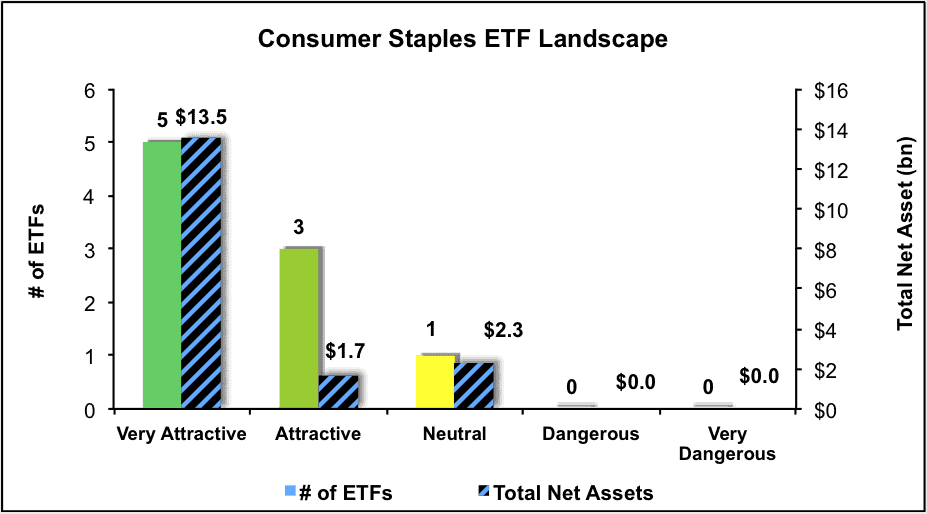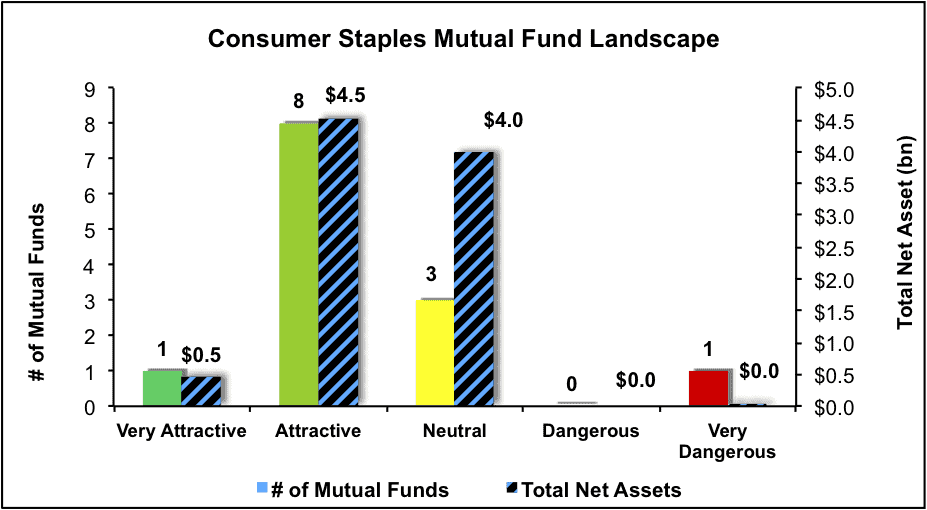Sector Analysis 4Q16
The Consumer Staples sector ranks first out of the ten sectors as detailed in our 4Q16 Sector Ratings for ETFs and Mutual Funds report. Last quarter, the Consumer Staples sector ranked first as well. It gets our Attractive rating, which is based on an aggregation of ratings of nine ETFs and 13 mutual funds in the Consumer Staples sector as of October 6, 2016. See a recap of our 3Q16 Sector Ratings here.
Figures 1 and 2 rank all nine ETFs and all 8 mutual funds in the sector that meet our liquidity standards. Not all Consumer Staples sector ETFs and mutual funds are created the same. The number of holdings varies widely (from 15 to 114). This variation creates drastically different investment implications and, therefore, ratings.
Investors seeking exposure to the Consumer Staples sector should buy one of the Attractive-or-better rated ETFs or mutual funds from Figures 1 and 2.
Figure 1: ETFs with the Best & Worst Ratings – Top 5
* Best ETFs exclude ETFs with TNAs less than $100 million for inadequate liquidity.
Sources: New Constructs, LLC and company filings
Figure 2: Mutual Funds with the Best & Worst Ratings – Top 5
* Best mutual funds exclude funds with TNAs less than $100 million for inadequate liquidity.
Sources: New Constructs, LLC and company filings
Fidelity Select Automotive Portfolio (FSAVX) is excluded from Figure 2 because its total net assets (TNA) are below $100 million and do not meet our liquidity minimums.
Guggenheim S&P 500 Equal Weight Consumer Staples (RHS) is the top-rated Consumer Staples ETF and Rydex: Consumer Products Fund (RYCIX) is the top-rated Consumer Staples mutual fund. Both earn a Very Attractive rating.
First Trust Consumer Staples Fund (FXG) is the worst rated Consumer Staples ETF and ICON Consumer Staples Fund (ICRAX) is the worst rated Consumer Staples mutual fund. FXG earns a Neutral rating and ICRAX earns a Very Dangerous rating.
116 stocks of the 3000+ we cover are classified as Consumer Staples stocks.
Pilgrim’s Pride Corp (PPC: $21/share) is one of our favorite stocks held by Consumer Staples ETFs and mutual funds and earns a Very Attractive rating. PPC was also a featured Long Idea in April 2015. Over the past decade, PPC has grown after tax profit (NOPAT) by 9% compounded annually. PPC has improved its return on invested capital (ROIC) from 2% in 2009 to a top-quintile 17% over the last twelve months. Despite the strong fundamentals, PPC remains undervalued. At its current price of $21/share PPC has a price-to-economic book value (PEBV) ratio of 0.9. This ratio means the market expects PPC’s NOPAT to permanently decline by 10%. If PPC can grow NOPAT by just 3% compounded annually for the next decade, the stock is worth $37/share today – a 76% upside
Mondelez International (MDLZ: $43/share) is one of our least favorite stocks held by Consumer Staples ETFs and mutual funds and earns a Very Dangerous rating. MDLZ was also a featured Danger Zone pick in March 2016. Since 2010, MDLZ’s NOPAT has declined by 5% compounded annually. The company’s ROIC has declined from 7% in 2005 to 6% over the last twelve months. Despite the deteriorating fundamentals, MDLZ remains priced for significant profit growth. To justify its current price of $43/share, MDLZ must grow NOPAT by 7% compounded annually for the next 11 years. This expectation seems rather optimistic given the profit decline at MDLZ since 2010. This scenario also assumes MDLZ is able to grow revenue and NOPAT without spending on working capital or fixed assets, which is an unlikely assumption, but allows us to create a very optimistic scenario. For reference, MDLZ’s invested capital has grown on average $1.1 billion (4% of 2015 revenue) per year over the past decade.
Figures 3 and 4 show the rating landscape of all Consumer Staples ETFs and mutual funds.
Figure 3: Separating the Best ETFs From the Worst ETFs
Sources: New Constructs, LLC and company filings
Figure 4: Separating the Best Mutual Funds From the Worst Mutual Funds
Sources: New Constructs, LLC and company filings
This article originally published here on October 6, 2016.
Disclosure: David Trainer and Kyle Martone receive no compensation to write about any specific stock, sector or theme.
Click here to download a PDF of this report.
Photo Credit: Jason Hamacher (Flickr)




